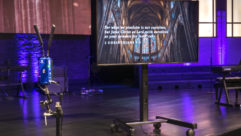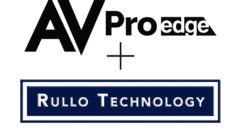

HDMI: Take It or Leave It
In case you hadn’t noticed lately, there’s been a big change in the connector panel of your new projectors, monitors, and video interfaces. Along with the usual composite, S-video, component, and 15-pin VGA jacks, you’re more likely to find an HDMI connector these days than a DVI connector.
In case you hadn’t noticed lately, there’s been a big change in the connector panel of your new projectors, monitors, and video interfaces. Along with the usual composite, S-video, component, and 15-pin VGA jacks, you’re more likely to find an HDMI connector these days than a DVI connector. “When did that start happening?” you ask. Oh, about three years ago, when display manufacturers decided to retain all of the connections used on the professional versions of their consumer LCD and plasma TVs.
And interface manufacturers said, “Guess we should be supporting those formats, too,” and began adding HDMI inputs and outputs to scalers and processors.
What happened to the DVI format? It seemed to work reasonably well, and indeed you’ll still find DVI on quite a few pro displays and projectors. But it’s obvious that display manufacturers would like to jettison DVI completely and switch to HDMI instead, particularly when you consider the latter’s ability to carry multiple channels of digital audio.
That’s not necessarily a bad thing, particularly if you have single-monitor applications that use the monitors’ built-in speakers. Having all that video and audio transport capability in a single cable is appealing. And if you’re installing a high-end consumer TV in a conference room or classroom, and you want to drive it with an upscaling red laser DVD or Blu-ray player, you’ll need to include HDMI connections.
But what if you’re just switching and distributing digital video? Isn’t DVI good enough for that?
The answer is an emphatic yes. DVI is indeed good enough and can, in fact, do anything HDMI can do, sans audio. DVI also has one big advantage over HDMI: Its mechanically secure connection, which will hold up under just about any mounting or environmental conditions.
HDMI, on the other hand, is designed for easy connection to consumer electronics. The connector does not lock per se, and only requires about three pounds of pull before it pops out, which would make installation in a high-vibration environment inadvisable. It would also seem to preclude unusual mounting schemes that might result in extra strain on the connector.
At least two companies have made attempts to secure HDMI connectors. PPC of East Syracuse, N.Y., (ppc-online.com) unveiled a locking HDMI connector at the Consumer Electronics Show that works with existing HDMI jacks and withstands a “pull” force up to 12 pounds. Another company, Blue Echo (blueechosolutions.com), came out with the HD EZ Lock, an adapter that secures existing HDMI connectors by fitting around them and using a setscrew to prevent the plug from migrating. It’s a bit more secure than the PPC connector, but it requires additional tools during installation and removal.
The problem here is that third-party manufacturers are fixing a problem that was created years ago by the original HDMI specifications. Even HDMI version 1.4 specifications make no mention of a locking connector–only of a new, smaller connector using 19 pins (see proavmagazine.com/hdmi).
Problems of Dominance
Other problems with HDMI have been legion, such as blank screens when switching HDMI sources and resolution conundrums when connecting more than one display. But those are being addressed by using writable EDID (extended display identification data) buffers within switchers and repeating or simulating valid EDID when switching from one video source to another, so as to prevent computers and DVD players from shutting down or going to sleep.
The real problem here is that the dominance of the consumer display industry is forcing AV integrators to deal with a host of interfacing issues they shouldn’t have to worry about. For now, HDMI is about all there is, and DVI is largely disappearing from the consumer marketplace.
HDMI: Take It or Leave It
In case you hadn’t noticed lately, there’s been a big change in the connector panel of your new projectors, monitors, and video interfaces. Along with the usual composite, S-video, component, and 15-pin VGA jacks, you’re more likely to find an HDMI connector these days than a DVI connector.
What about DisplayPort? The original DisplayPort 1.1 specification was released last year by the Video Electronics Standards Association (VESA) and is slowly winding its way through the display electronics world. As of this writing, only a few products have incorporated DisplayPort connectors and I have yet to see it show up on a commercial AV interface.
The nice thing about DisplayPort is that it was designed by consensus, and as a result is likely to catch on quickly in desktop and notebook computing. That means we should eventually see monitors and projectors that incorporate DisplayPort.
One big advantage DisplayPort has over HDMI is its support for direct-drive monitor (DDM) designs, which are display panels that eliminate lots of internal video processing electronics. In theory, this could simplify monitor design considerably, not to mention cut down on weight and cost. The panel is simply driven directly from the computer’s video card or from a server (take note, digital signage designers!).
Of course, there’s an interoperability issue. On March 12, VESA issued an Interoperability Guideline for DisplayPort cable adapters, aimed primarily at you-know-who. To quote from the press release, “There is industry interest in establishing a means for achieving interoperability between DisplayPort Devices and DVI 1.0/HDMI-compatible devices. For example, it is desirable to have the ability to connect a cable between a DisplayPort source device and a DVI 1.0/HDMI sink device (or vice versa) and have the devices interoperate. This cannot currently be accomplished at the specification level, but can be accomplished at the product level.”
Well, good luck with that. I’m sure you’re familiar with the list of “big lies,” such as “The check is in the mail.” “Simple interface” has been used so many times for marrying HDMI and DisplayPort signals that it might be a candidate for the list.
Long story short, we’re stuck with HDMI. So learn to live with it, and make sure any video signal distribution devices in your system are EDID-friendly. And maybe if we’re lucky, someone will design a true, professional HDMI connector. Cross your fingers.
Pete Putman is a Pro AV contributing editor and president of ROAM Consulting in Doylestown, Pa.










